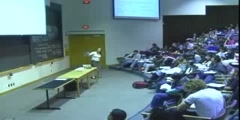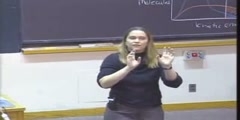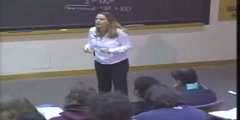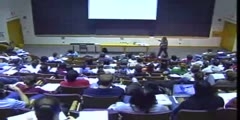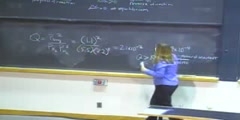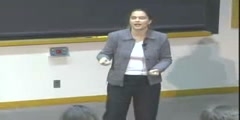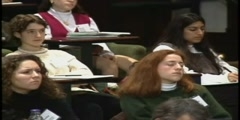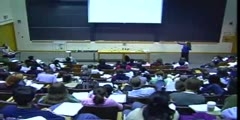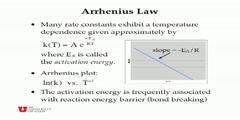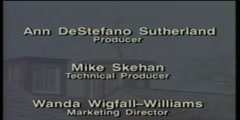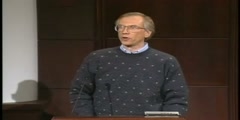Chemical Science - Kinetics: Catalysis - Lecture 35
Principles of Chemical Science/n * Email this page/nVideo Lectures - Lecture 35/nTopics covered: /nKinetics: Catalysis/nInstructor: /nProf. Catherine Drennan/nTranscript - Lecture 35/nWe were talking about factors affecting the rates of reaction./nAnd so we have gone through a number of these. We talked last class about the affect of temperature. We talked about mechanism last Wednesday, we talked about nature of material and concentrations in the lectures preceding that, and now we are up to the last thing that we had on our original list which are catalyst./nToday we are going to talk about catalysis. This is on the lecture summaries that will arrive for you. A catalyst is a substance that takes part in the reaction but is not consumed in the reaction./nIt is a bystander of the reaction. It will speed it up, but it does not undergo any permanent change itself. That is the definition of a catalyst. Catalysts, because they are not changing in their form, are not part of an overall balanced equation./nSometimes you will see a balanced equation and a thing over the arrow, which will indicate the conditions in which the reaction was done. And often information about a catalyst that was used in the reaction will be present there./nWhat are catalysts actually doing? Here is the potential energy diagram that we looked at last time. And in this diagram you have some energy for reactants. Energy for products down here. There is an overall charge, delta E between the reactants and the products./nAnd, again, delta E is very similar to delta H. It is only 1% or 2% off for gases and almost the same for liquids and solids. It is information about the thermodynamics. This is a calorimetry, a thermodynamic measurement./nAnd then we saw that there is an activation energy. This is at EA for the forward reaction that the molecules need to overcome, a critical energy that they need to overcome before they can go on and form products./nThat energy barrier is there because when molecules come together and attempt to react, usually there is some amount of bond distortion that has to occur, things are rearranging and you form usually some kind of intermediate activated complex or transition state./nAnd, when you get up there, if the molecules have enough energy to react then they can go to products. If they don't have enough energy to react, if there is not enough energy to distort those bonds and form this activated complex then they will fall back apart to reactants./nFor an elementary reaction, there is always some barrier to overcome. And I think about activation energy barriers in my own work all the time. It seems like whenever I have to sit down and do something, start writing a paper, write a grant, write the final exam, there always seems to be some activation energy barrier to getting started./nAnd, once you get started, if you get to this point then it is all downhill and things go much more smoothly. But, in the beginning, it always seems like every reaction or every task has some kind of activation energy barrier./nUp at this top part there, with this dash line, then there is a transition state or an activated complex. And here is the barrier without the catalyst, here is the energy barrier without the catalyst and the line for the transition state./nAnd, again, if we go in the reverse direction of this, there is an activation energy for the reverse reaction here. And these will all sum up, so delta E is going to be equal to the activation energy for the forward reaction minus the activation energy for the reverse reaction./nWhat does adding a catalyst do? Well, adding a catalyst lowers that activation energy barrier. That is shown here in the blue line. And this is also in the handout. This is the energy barrier with a catalyst, so it is lower./nAnd then the transition state with a catalyst will also be lower. And so one way that you can think about this is that a catalyst lowers or stabilizes the transition state. All right. Let's add a few more things to this diagram then./nThere will be a new activation energy for the forward reaction, shown in blue. It is not as high a barrier now. It's lowered down. And there will be a new activation energy for the reverse reaction, shown in blue./nThese are the values then with the catalyst. A catalyst is going to lower both the activation energy for the forward reaction and the activation energy for the reverse reaction. And that is what is said here./nIt lowers both barriers, forward and reverse. And another way to express this is that the catalyst stabilize this transition state or activated complex. They are going to lower the energy or stabilize this state./nAnd this way of thinking about this, we will come back to at the end of the lecture. It is something that is used by pharmaceutical companies in terms of designing inhibitors of enzymes to think about this./nCatalysts have no affect on the thermodynamics of the reaction. They are affecting the rate of the reaction but not the thermodynamics of the reaction. You see that delta E is not changing in this at all./nIt is the same energy difference between reactants and products. That term is not changing, and also delta G would not change. Delta G is a state function. It is independent of the path so it is not going to change./nIt does not care if it had to go over a higher barrier or a lower barrier. It is independent of the path of the reaction. It just cares about where it ends up. Delta G is not going to change with a catalyst./nTherefore, equilibrium constant is not going to change with a catalyst. What you are changing is the activation energy barriers, again, the forward and reverse reaction, and you are speeding up then the reaction./nThe Chinese symbol for a catalyst is a marriage counselor. You can think about the catalyst as really facilitating those molecules coming together and having enough energy to react. Say, if they were at a lower temperature, it would be harder to get over that activation energy barrier./nA catalyst, or a molecule counselor will help lower that barrier and make it more likely for these molecules to have that energy to react and go onto product. And that will speed up the reaction. We talked last time about if you are high temperature or low temperature./nIf you are higher temperature more molecules can overcome the barrier. Lower temperature makes it harder to do that. A catalyst facilitates things by making the barrier lower. That is what a catalyst can do./nAnd, in terms of your own thinking about things, if you have big activation energy barriers for, say, studying for things or writing a final paper. You can think of catalysts as being the due being the next day, so you have run out of time./nThat can be a big catalyst and lowering that barrier and helping you get started. Caffeine works for a lot of people in terms of getting over those activation energy barriers. You can think about in your own life, what are good catalysts that help you get over those barriers? OK./nAnd inhibitor then would be the opposite of a catalyst. And it will slow the rate of a reaction. And it can increase the activation energy barrier. An inhibitor is going to be the opposite. And, again, we will talk more about inhibitors at the end of today's class./nThere are a couple types of catalysts. You can talk about homogenous catalysts. And that is when the reactant and the catalyst are in the same phase. An example would be in the depletion of the ozone layer by chlorofluorocarbons./nThose are all in the gas phase, so this acts as a catalyst. It catalyzes the depletion of ozone, which is why people have been very concerned about spray cans and other things that release these molecules into the environment./nYou can also have heterogeneous catalysts, so something that is in a different phase as the reacting molecules. And we are all familiar with examples of this, like a catalytic converter. In this case, your catalyst would be solid metals, platinum, platinum, rhodium./nAnd they will help catalyze oxidation of hydrocarbons, CO gases, reduction of nitrogen oxides to reduce pollution. The reactant molecules are gases, but the catalyst is a metal. It is heterogeneous./nIt is in a different phase. So, these two examples. I will just show you a little movie of heterogeneous catalysis. Could some of the TAs help? The lecture notes are here. This movie is not in the lectures notes./nWe have here a metal surface in blue. And the metal is acting as a catalyst. And in gray we have these two dots. Those are hydrogens. What the metal did was help to facilitate the dissociation of H2./nH2, which is not so reactive, has been dissociated and you have broken into the two separate hydrogens. And now if we bring in a molecule of ethane then it will react with this. You have a molecule come in, in a different phase./nAnd see how the hydrogens just kind of bop right onto the molecule? The metal surface was acting as a catalyst making the H2 gas, I will just do that one more time, more reactive by having it dissociate first./nNow they are sitting on the metal surface and the reaction is quite a bit faster. That would be an example of the heterogeneous catalysis. All right. Now I am going to talk about my favorite kind of catalysts, catalysts of life or enzymes./nEnzymes are catalysts. And if you are a biochemist, enzymes are your favorite kind of catalyst. An enzyme is usually a protein. There are some examples of RNA catalyzing reactions, but most enzymes are made up of protein./nAnd they are usually fairly large. The sort of smallest molecular weight you might see would be about 20,000 grams per mole. Again, some people on Exam 3, I will just point this out, when I asked for units of molecular weight, grams per mole, some people didn't have the right units for that./nAnd that is the same molecular weight if you are talking about a weak acid or you are talking about an enzyme. Same units but different size. These enzymes are capable of catalyzing a wide variety of different reactions in your body./nProteins or enzymes are made up of amino acids. And amino acids have carbon, nitrogen, oxygen and sulfur in them. And I will share with you a little recent story. We have a collaborator who is in France./nThey tried to send us some protein to do crystallization experiments. I got a call from Customs. There was a Dewar with this protein sitting in New Jersey. And Customs was calling me and said they couldn't release this material from Customs without more information./nThey said it says here that the Dewar contains protein, and we need to know what that protein is made of. And we also need to know who had manufactured the protein. And so now you can all answer the question if Customs calls./nProteins are made up of amino acids. I am not really sure what they were getting at here. And, in terms of who had manufactured it, it was E. coli bacteria. We were actually afraid of saying that because there are strains of E./ncoli that seem to every once in a while make people very sick at McDonald's and White Castle and places like that. E. coli has now become sort of a dangerous bacteria, so we said the protein was made up of amino acids like you buy at the health food store and the manufacturer was ìnatural sourcesî./nThe protein was released to us, but apparently the person at Customs had not had much chemistry or biochemistry in their background. All right. Proteins are made up of these amino acids. Here is an amino acid./nProfessor Ceyer talked about this before in terms of ìbad hair daysî. Amino acid. Here we have an amino group, a carboxylic group and a carbon, which is called alpha carbon. It is sitting in the middle./nAnd there is a group R, and that can be 20 different kinds of side chains that make up the 20 amino acids that are commonly found in proteins. And so one amino acid gets linked to another amino acid through what is called the peptide bond shown here./nAnd so here we have our first amino acid and our second. Again, you can have hundreds and hundreds of amino acids connected to each other. Then they fold up into some kind of compact structure for the enzyme./nIn this particular case, there are four different chains of peptides. Each chain has 198 amino acids. Each chain in this picture is shown in a different color, yellow, green, red and blue. And in these diagrams they don't show all the atoms, because that would just kind of be a big mess, if you showed all the atoms./nInstead, a ribbon is drawn through the positions of the alpha carbons of every amino acid. And so these kind of squiggly things here are alpha helices, which is one type of secondary structure. You will learn about that in 5.07 or 7.05./nArrows are often indicated what's called beta sheets, extended regions of the amino acids. And so think kind of gives you a general sense of what we call the folds of the protein in these diagrams./nAnd so this gives you a sense of how big this molecule actually is. And we report things in angstroms typically because that is a good unit of measure that helps tell you about how far apart the atoms are in structures./nWhat is this particular enzyme? Well, this particular enzyme is involved in catalyzing the last step in the biosynthesis of an antibiotic called phosphomycin. And so this is the reactant or substrate./nAnd this is the product phosphomycin. What phosphomycin does is inhibits cell wall biosynthesis of bacteria and forms a covalent adduct with amino acid in the active site of one of the important enzymes in cell wall biosynthesis./nAnd so a lot of antibiotics target cell wall biosynthesis. It was first approved to treat mostly like bladder infections and sort of more minor types of infections, but recently they found that it works against strains of staphylococcus aureus infection, which is pretty serious./nThere are several strains of staph infection now that are resistant to some of the powerful kinds of antibiotics that had been used before. And so they are looking for new antibiotics that might be successful in treating those infections./nAntibiotic resistance of certain kinds of bacteria has become a really enormous problem, and is just getting worse. I always like to ask a crowd like this, how many have taken antibiotics zero times in their life first? Never taken antibiotics./nI don't see anybody. How about once? Three people. Twice? A few more. Three times? You probably don't remember. Say around maybe five or more or something like that? OK. You can see, from looking around, why this is a problem./nBacteria are cleaver. They figure out and try to get around ways because they want to survive, so there is some nice natural selection going on. And there are actually resistant strains to phosphomycin as well./nAnd what happens in that case, as I said, is it works by becoming attached to amino acid and then the enzyme is dead. But if that amino acid is mutated, it is a cysteine. If it mutates to an aspartic acid then it can no longer be inhibited by this and it still works./nIt is not as good an enzyme but still works. If there is pressure applied, natural selection die or mutate, a lot of things will be very happy to mutate if they can. Some of the antibiotics, if it mutates, only just one amino acid changes, all of a sudden there is a resistance going on./nThe more times that bacteria are exposed to antibiotics, the more likely it is they will mutate in such a way that they will be resistant in the future. This is a really huge problem. If you're thinking I'm interested in science, what should I do with my life? This is one thing that you might want to think about./nA lot of what we take antibiotics for used to be conditions that were deadly. If we don't have antibiotics then life expectancy is quite a bit different. Anyway, this is one of the projects in my lab./nWe're looking at a number of different enzymes that are involved in antibiotic biosynthesis. All right. Enzyme catalysis. I am going to introduce you to a few terms. And then what we are going to do is we are going to use the things that you learned, mostly last Wednesday, on mechanism of reactions./nAnd we are going to derive the Michaelis-Menten equations for enzyme kinetics. You might not have realized that on Wednesday you were learning all the sort of tools you need in biochemistry, you were actually learning biochemistry, but you were./nAnd I think you will see that now. First, a couple of new terms. I already introduced this a little bit, but reactant molecules, we're always talking about reactants. When you are talking about enzymes, you are talking about substrates./nWe no longer call them reactants. We now call them substrates. Substrates bind to what is known as the active site of the enzyme. That is the site where catalysis occurs, so it is active. That is pretty easy to remember./nHere is a very simple enzyme reaction. And a lot of enzyme reactions actually are fairly simple. Here you would have an enzyme binding to your substrate. Enzyme called E. Substrate called S. When the substrate binds to the enzyme, it forms an enzyme substrate complex, which is known as an ES complex./nThat enzyme substrate complex, or ES complex will go on and form enzyme E and product P. Just to show that in cartoon form, and it pains me to do this, to draw the enzyme like this. Because, as you saw in the last slide, enzymes are really quite beautiful./nAnd this is a very sad description of what an enzyme looks like. Also, here the substrate is about the size of the enzyme, which is also all off. But here is a substrate binding the enzyme. This would be the active site and would be designed just to fit the substrate in there quite nicely./nWhen substrate binds to the enzyme, you form what is known as the ES complex. And usually this binding is reversible. Not all substrate that binds to the enzyme will go on to form product. Some will go back and form free substrate and enzyme./nAnd, in this drawing, then when the enzyme reacts on the substrate, it will form product and free enzyme again. And this is drawn with a single line as not being a reversible step in the reaction. Here you see substrate, and what this enzyme did is sort of make the substrate look a little more like Mickey Mouse./nThere is our product coming off. Now we can derive equations to represent that reaction that I just showed you. And we can use all the same ideas that we had when we were deriving mechanism in class last Wednesday and on Problem Set 10./nAgain, the reaction is enzyme plus substrate, E plus S going in a reversible step to the enzyme substrate complex ES, and then going with a single non-reversible step to enzyme and product. We can put this in two steps./nStep 1 is the reversible step of enzyme and substrate going to the enzyme substrate complex with rate constants k1 for forward step and k-1 for the reverse step. In Step 2, we have the enzyme substrate complex going to enzyme and product with rate constant k2./nThese then are elementary reactions, and so we can write the rate law for each step just based as how the reaction is written. What would be the rate for the forward reaction? K1 times E times S. All right./nThere is the rate for the forward reaction. Again, just based on rate constant times the two things that are reacting. What about for the reverse reaction? What's the rate constant? K-1 times ES, right./nThat would be for the reverse reaction. And what about the rate for Step 2? K2 times ES, right. OK. Now we can look at the rate of formation of product, the overall reaction. The rate of product formation can be expressed as the change dPdt with time for product./nAnd also we can just write it from the second step in terms of k2 times ES. That is the rate of formation of product. Are we done? No, because why? There is an intermediate, so we have to solve for the intermediate./nAgain, this should seem familiar. It is all the same stuff we were talking about last week. We need to solve for the intermediate. We are not given anything about fast and slow steps, so we are going to use the steady-state approximation which is going to tell you that the net formation of intermediates is pretty much constant./nIt is in the steady-state. Another way to express that is that all the steps that form the intermediate are equal in rate to all the steps that get rid of that intermediate. Either consume it or decompose it./nFirst we need to look at what all the steps are that have to do with the intermediate. Here is the rate of the formation of that intermediate. And so that is going to be equal to the steps involved in forming the intermediate./nAnd it is only formed in that first step, forward direction of the first step. Its rate k1 times the concentration of E times the concentration of S. That's the rate of formation. And then we are going to subtract from that steps that are involved in the decomposition or in the consumption of the intermediate./nThe intermediate decomposes in the reverse direction of Step 1. That is this rate k-1 times ES. And it is also consumed in this second step. It is consumed by the rate k2 times ES. Again, this is exactly the same as what we looked at last week./nNow we can consider the steady-state approximation, and we can set that whole term equal to zero. Steady-state again, the net rate of formation of the intermediate is equal to the net rate at which it goes away./nThe whole equation can be set equal to zero. We can do that here, set this term equal to zero. Now there is a slight change. It is not 100% what we did before. There is a slight change. And that comes out of a practical consideration./nWhen you are doing these experiments, in the term that we had, you usually don't know how much enzyme is free. And it is hard to figure that out, at any one time, how much enzyme is not reacting with a substrate./nIt is much easier to know how much enzyme you added to the reaction to begin with. That is a number that you should know. You should have carefully figured out how much enzyme that you were going to use in your experiment./nInstead of solving for the intermediate in terms of the free enzyme, it is easier to solve for it in terms of the total enzyme, which we are going to call E knot, how much enzyme you put into the equation./nThe total enzyme that is reacting with substrate that you put into the experiment would equal the amount that is free, the amount that is not reacting at any given time or that just finished reacting and the amount of the enzyme that is bound./nIt is only going to be free or bound. The total enzyme equals these two. And so you can go back to your other equation right now. And whenever you had free enzyme, you can substitute in terms for total enzyme minus bound, because that is going to be equal to free./nAgain, this is just a practical consideration that it is easier, if you are doing these experiments, and, again, biochemistry is an experimental science, to know how much enzyme you started with than to know how much is non-reacting at any given time./nThis is just a practical thing. And for all the other things we worked on, you are always wanting to solve for the intermediate in terms of things you could measure like rate constants and concentration of reactants or products./nIt is a similar kind of idea. You want to be able to solve for things in terms of stuff that you can actually measure. Now we can go back. Again, this is the equation that we were solving for our intermediate./nIf you use the steady-state approximation, you set the whole term equal to zero. Now we can take this term and substitute. We are going to replace this E, and that is the only free enzyme that we had in this whole expression./nWe are going to replace this now with total enzyme minus the bound enzyme. We are going to put that term in here, and that gives us the following. Now we have k1S times, in parentheses, this term, which equals free enzyme total minus bound./nAnd now we can multiply that out. K1S times total enzyme here. And then there is a minus here. We have k1ES times substrate over here. And these parts are unchanged. Now we can solve for ES. Here is our expression from the last sheet./nNow we can rearrange to solve for ES. We are going to put all the ES terms onto one side. Here is an ES term, here was an ES term and here was an ES term, so we moved those down to the other side of the equation./nIt gets rid of the negative. Bring that over. Bring that over. And the only thing on the other side of the equation is this term here k1 times total enzyme times substrate. Now we can go ahead, as we did before, and pull out all of these ES terms and come up with an expression that solves for it./nSo we are going to solve for ES. We pulled out ES here. We have k1S, we have k-1, and we have k2. We have this expression over here. And now we can take this expression and divide by that term. And so this gives us an expression then for the concentration of our intermediate./nNow we are going to do one other thing that is a bit different. This term has a lot of Ks in it. And so we are going to substitute these Ks for another term that is more convenient to measure than any of these are by themselves./nAgain, this is a practical consideration. You want to be able to use these equations to get information about enzyme kinetics. And so the term that we are going to introduce is called big K to the little M, the Michaelis-Menten constant./nAnd so the Michaelis-Menten constant, we will talk about what this really means, what this constant means in practical terms in a couple minutes, Km equals k-1 plus k2 divided by k1. Now we somehow want to get this term into this expression./nHere is the expression again. We want this term in here. If you notice at the bottom here, there is a k-1 and a k2, just like there is here. If we divided these two by k1 we would have Km over here./nBut, if we do that, we have to divide everything by k1. Let's divide everything by k1 and turn this part of the expression into a Km. If we do that, we divide the top term by k1, we divide this term here, k1S by k1, and we divided these two by k1./nWe do that because now this is going to be equal to Km. All right. We can simplify this expression. We have various things that we can cross out. If we do that, you can cross these two out up here./nYou can also cross these two out down here. And what does that leave us with? That leaves us with this. The top term we have total enzyme concentration times substrate concentration over substrate concentration plus this term here, which is Km./nWe have taken something that was a little bit more clunky and turned it into an expression that has fewer terms, including this new term that is used for enzyme kinetics, this Km term. Now we can finally go back and take our term for the concentration of the intermediate and plug it into our rate law for formation of product./nAgain, this was our expression for the rate of product formation, k2 times the concentration of ES. And we can take this and plug that in here. And that gives us this term k2 times total enzyme times substrate over substrate plus Km./nAnd this is the Michaelis-Menten equation. We used the steady-state approximation. We solved for an intermediate. We did two things differently. We didn't solve for free enzyme. We solved for total enzyme./nAnd we also introduced this term Km and took out some of the individual rate constants and expressed them in terms of this constant. Here is our rate equation for formation of product. Now let's think about what this equation can do, what it means, what happens when enzyme is making product, is acting as the catalyst and turning our substrate into product./nHere would be a graph of what it might look like. You have here the rate of formation of product expressed as dPdt. That is just rate of product formation versus substrate concentration. And you see that the curve goes up and then levels off./nWhat is happening in this case? Well, at low substrate concentration and down here, this is low substrate concentration, when you add more substrate the rate goes up quite quickly and then starts to level off./nAnd at low substrate concentration, adding more substrate increases the rate a lot, because there is a bunch of enzyme that is free, that is just hanging out. And it is not making product because it doesn't have any substrate./nBut you give it substrate and it will quickly make product. That is what is happening. You have lots of free enzyme around. It is ready for substrate. When you add substrate, it reacts. Lots of product is formed./nWhy would it level off? Well, it will level off at higher substrate concentration because, at higher substrate concentrations, there really is any free enzyme around anymore. Adding more substrate, when the enzyme already has substrate bond, is not going to increase the rate at which the product is being formed./nWe say that the enzyme is saturated. The enzyme already has as much substrate as it can use. And you just have to wait until it finishes the reaction to product before a new substrate can be bound./nThe rate is going to level off at some point because there is no free enzyme around. You have saturated with substrate. Adding more does not help your rate. We can think about this in terms of the Michaelis-Menten equation./nWe can think about when substrate concentrations are really high, when you have lots of substrates. And we can think about that in terms of this value for Km. Again, we are looking here at the bottom of this equation and we are thinking about how big is this term compared to that term./nUnder conditions of the experiment where substrate concentration is a much bigger number than Km, we can get rid of the Km term, so we can cross this out. Again, if you have a really big number in the denominator added to a much smaller number./nThe much smaller number is not really contributing much and you can just get rid of it. Now, we can simplify this equation then, if we did that. What else could we cancel out? We can cancel out S./nWe can get rid of our substrate. And that leaves us with this expression. That the rate of formation, a product under these conditions, when substrate is a much bigger number than this Km term, then we get this expression that the rate is just equal to k2 times the total enzyme that we had in our reaction./nAnd this has a name. It is called Vmax. Vmax equals k2 times total enzyme, and Vmax is the maximum rate of the reaction. And so, when you have lots and lots of substrates, you are under these conditions where you can determine the maximum rate of the enzyme./nThe Vmax of the enzyme. And it is only equal to this k2 times how much enzyme you had in that particular experiment. Again, the maximum rate of the enzyme under these conditions. Again, that would be up here./nThe rate levels off. When you have high substrate concentration then you are at the maximum rate. The enzyme cannot go any faster at that point. The rate depends on how much enzyme you have and the k2 term./nNow let's consider this scenario where these two terms at the bottom of the expression are equal to each other, when substrate equals Km, the concentration of substrate equals Km. If those are equal, we can get rid of the Km term and put in another substrate term because they are equal./nWe will just put in another substrate term. Then we can simplify again. Two substrates are down here. One is up here. We can cancel one of them and get the following. We cancel one. We have =k2 times the total enzyme concentration./nAnd this would be then the half maximal rate. The maximal rate was k2 times the total enzyme concentration. Half maximal is half that rate. And now we can finally define Km. We can define Km as the concentration of substrate for which the rate is half maximal./nThe concentration of substrate, when you have this half maximal rate. That is what Km is. And so this is a term that is easy to measure then. That is why we did some manipulations to get it into our equation, because it is a term where you can find the answer, the Km value./nIf you know the maximal rate, you can find the half maximal rate and figure out what substrate concentration gives you that half maximal rate. And that is just going to be your Km. In some problems that you are going to have, and the extra problems that are posted, it may tell you the maximal rate and then tell you the substrate concentration that gives you the half maximal rate and you have to find the Km./nWell, that is not a hard problem. If you are told the substrate concentration that gives you the half maximal rate, that is the Km. It is just a matter of knowing the definition. The levels of problems that you have in your chapter on enzyme kinetics are really pretty simple./nIf you know some of the definitions, you are all set. Finally, let's just look at inhibitors in the last few minutes. This is a very simplistic view of an inhibitor situation. If your inhibitor is I, it may bind to your free enzyme to give you an EI complex, an inhibitor bound complex./nIf the inhibitor is bound in the active site and it is bound pretty well, substrate is going to come along. But it cannot bind so you cannot make any product. The inhibitor has stopped the activity./nThat is just a very simplistic scheme of what can be going on. Many pharmaceuticals work on enzyme inhibitors. That is what they do. They stop enzyme biological catalysts. The way in which they work often is that the inhibitor is designed to mimic the transition state of the reaction./nIf you have things coming together and they form an activated complex or a transition state before they go on to, say, form products, often the inhibitor is designed to look like that transition state that is formed./nThe reason why it would do this is because molecules that resemble the transition state should bind more tightly to the enzyme than either the reactants or the products. Therefore, they can serve as effective inhibitors./nIf you just recall what we showed at the beginning of the talk, catalysts work by lowering this barrier or by stabilizing the transition state, bringing the transition state to a lower energy. And so often inhibitors that look like a transition state will bind to the enzyme quite tightly./nAnd you want the inhibitor to bind tightly because you don't want substrate to be able to come along and displace the inhibitor. If you are trying to stop the enzyme from working, you want a tightly bound inhibitor, so they often look to the transition state./nAnd let me just give you one example that has been pretty successful, and that is with protease inhibitors. Protease inhibitors are used in the treatment of HIV. The proteases are enzymes which cleave peptide bonds./nAnd so we talked about the formation of a peptide bond. This is a reaction that catalyzes the reverse process breaking down the peptide bond. And so here might be a simplified reaction mechanism. You have something coming and attacking./nHere is your peptide bond. You are forming a tetrahedral intermediate here. And what would be the angles of a tetrahedral intermediate? 109.5. And then this would break down and you would form these two products, so the peptide bond then gets cleaved./nAnd so designers of inhibitors or pharmaceutical drugs have tried to mimic this tetrahedral intermediate to try to get tight binding. You have the idea that molecules with this stable tetrahedral site that cannot be cleaved could bind to the enzyme more tightly than substrate./nAnd this is just one example of a drug that inhibits HIV protease that has that stable tetrahedral site where that cannot be cleaved. I am also done. Here is a picture of it bound to the enzyme. Here is the inhibitor bound to the active site./nIt fits quite well in there. And let me just mention finally that one problem with designing inhibitors toward enzymes, there are, in this case, many proteases. You might not want to stop all proteases from working./nYou only want to stop the HIV protease from working. There are a lot of issues of specificity. That is one of the complication of drug design. And that, again, is another important area for you to think about doing./nThere is still a huge problem with HIV. Not as much in the US, but in other countries. That is something else you can think about doing. All right. See you
Channels: Chemistry (General)
Uploaded by: mitlectures ( Send Message ) on 16-04-2009.
Duration: 48m 23s
